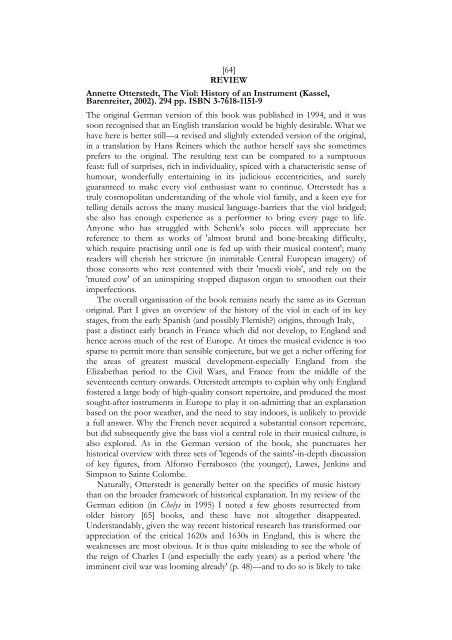download.pdf - 1.2Mb - Viola da Gamba Society
download.pdf - 1.2Mb - Viola da Gamba Society
download.pdf - 1.2Mb - Viola da Gamba Society
You also want an ePaper? Increase the reach of your titles
YUMPU automatically turns print PDFs into web optimized ePapers that Google loves.
[64]<br />
REVIEW<br />
Annette Otterstedt, The Viol: History of an Instrument (Kassel,<br />
Barenreiter, 2002). 294 pp. ISBN 3-7618-1151-9<br />
The original German version of this book was published in 1994, and it was<br />
soon recognised that an English translation would be highly desirable. What we<br />
have here is better still—a revised and slightly extended version of the original,<br />
in a translation by Hans Reiners which the author herself says she sometimes<br />
prefers to the original. The resulting text can be compared to a sumptuous<br />
feast: full of surprises, rich in individuality, spiced with a characteristic sense of<br />
humour, wonderfully entertaining in its judicious eccentricities, and surely<br />
guaranteed to make every viol enthusiast want to continue. Otterstedt has a<br />
truly cosmopolitan understanding of the whole viol family, and a keen eye for<br />
telling details across the many musical language-barriers that the viol bridged;<br />
she also has enough experience as a performer to bring every page to life.<br />
Anyone who has struggled with Schenk's solo pieces will appreciate her<br />
reference to them as works of 'almost brutal and bone-breaking difficulty,<br />
which require practising until one is fed up with their musical content'; many<br />
readers will cherish her stricture (in inimitable Central European imagery) of<br />
those consorts who rest contented with their 'muesli viols', and rely on the<br />
'muted cow' of an uninspiring stopped diapason organ to smoothen out their<br />
imperfections.<br />
The overall organisation of the book remains nearly the same as its German<br />
original. Part I gives an overview of the history of the viol in each of its key<br />
stages, from the early Spanish (and possibly Flemish?) origins, through Italy,<br />
past a distinct early branch in France which did not develop, to England and<br />
hence across much of the rest of Europe. At times the musical evidence is too<br />
sparse to permit more than sensible conjecture, but we get a richer offering for<br />
the areas of greatest musical development-especially England from the<br />
Elizabethan period to the Civil Wars, and France from the middle of the<br />
seventeenth century onwards. Otterstedt attempts to explain why only England<br />
fostered a large body of high-quality consort repertoire, and produced the most<br />
sought-after instruments in Europe to play it on-admitting that an explanation<br />
based on the poor weather, and the need to stay indoors, is unlikely to provide<br />
a full answer. Why the French never acquired a substantial consort repertoire,<br />
but did subsequently give the bass viol a central role in their musical culture, is<br />
also explored. As in the German version of the book, she punctuates her<br />
historical overview with three sets of 'legends of the saints'-in-depth discussion<br />
of key figures, from Alfonso Ferrabosco (the younger), Lawes, Jenkins and<br />
Simpson to Sainte Colombe.<br />
Naturally, Otterstedt is generally better on the specifics of music history<br />
than on the broader framework of historical explanation. In my review of the<br />
German edition (in Chelys in 1995) I noted a few ghosts resurrected from<br />
older history [65] books, and these have not altogether disappeared.<br />
Understan<strong>da</strong>bly, given the way recent historical research has transformed our<br />
appreciation of the critical 1620s and 1630s in England, this is where the<br />
weaknesses are most obvious. It is thus quite misleading to see the whole of<br />
the reign of Charles I (and especially the early years) as a period where 'the<br />
imminent civil war was looming already' (p. 48)—and to do so is likely to take
















